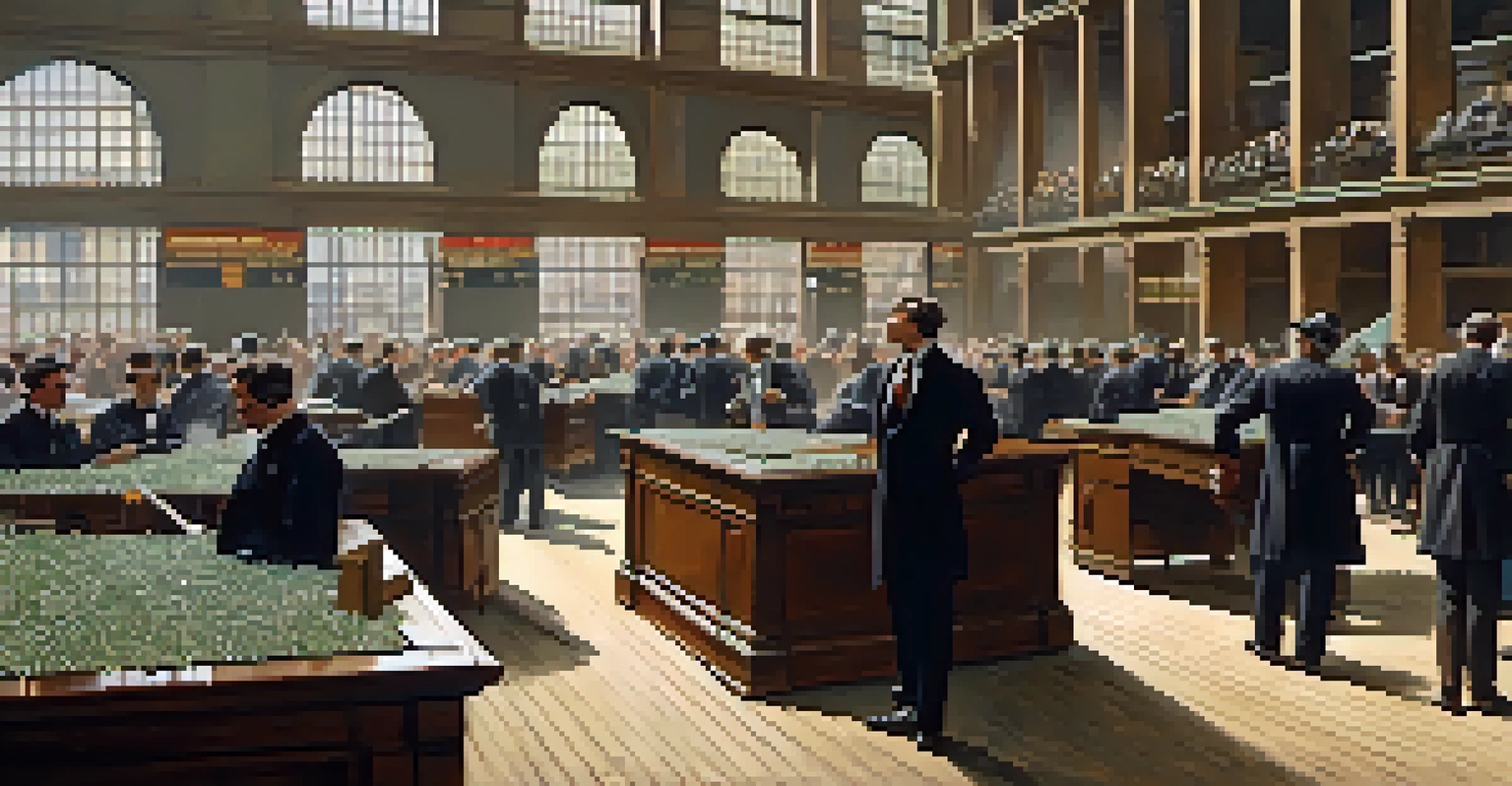The Birth of the Chicago Stock Exchange

Understanding the Need for a Stock Exchange in Chicago
In the mid-19th century, Chicago was emerging as a major commercial hub, driven by its strategic location and booming industries. However, the absence of a centralized marketplace for trading stocks hindered the city's economic growth. Investors and businesses were seeking a reliable platform to facilitate trades and manage investments more effectively.
The stock market is filled with individuals who know the price of everything, but the value of nothing.
With the rapid expansion of railroads and agriculture, the demand for a structured financial system became apparent. The need for a place where buyers and sellers could connect and negotiate terms was crucial for supporting the burgeoning economy. This increasing demand laid the groundwork for the idea of establishing a stock exchange in Chicago.
The vision for a stock exchange was not just about trading stocks; it was about fostering growth and stability in the local economy. It aimed to provide transparency and efficiency in transactions, which were critical for the growth of various sectors in Chicago.
The Establishment of the Chicago Stock Exchange in 1882
The Chicago Stock Exchange (CSE) was formally established in 1882, marking a significant milestone in the city's financial landscape. A group of influential businessmen and brokers recognized the potential for a formalized trading platform and came together to create the exchange. This initiative was driven by the need for a more organized approach to trading stocks and commodities.

One of the unique aspects of CSE was its structure, which allowed for both stock and commodity trading under one roof. This dual focus attracted a diverse range of investors and traders, fostering a sense of community and collaboration. The exchange quickly gained traction and became a vital part of Chicago’s economic framework.
Chicago Stock Exchange Established
The Chicago Stock Exchange was founded in 1882 to create a centralized platform for trading stocks and commodities, strengthening the city's economic framework.
The establishment of the CSE not only facilitated stock trading but also contributed to the city's reputation as a financial center. It provided a platform where local companies could raise capital, and investors could participate in the city's growth, thus creating a symbiotic relationship between businesses and the finance world.
The Role of Technology in the CSE's Early Years
In its early years, the CSE relied heavily on the technology of the time, which was quite rudimentary compared to today’s standards. Communication methods included telegrams and ticker tapes, which enabled traders to receive information about stock prices and transactions. This reliance on technology was crucial for facilitating trades and keeping investors informed.
In investing, what is comfortable is rarely profitable.
As the demand for faster and more efficient trading grew, the Chicago Stock Exchange began to adopt more innovative technologies. The introduction of electrical ticker systems in the 1880s marked a significant advancement, allowing for real-time updates on stock prices. This innovation not only improved efficiency but also enhanced transparency in the trading process.
The evolution of technology at the CSE set the stage for future advancements in the financial sector. It demonstrated how embracing innovation could lead to increased participation and trust among investors, ultimately solidifying the exchange's role in the economy.
Challenges Faced by the Chicago Stock Exchange
Despite its initial success, the Chicago Stock Exchange faced several challenges in its formative years. One of the most significant hurdles was the competition from other established exchanges, especially in New York. Traders often gravitated towards these larger exchanges for their perceived reliability and larger network of investors.
Economic downturns and market fluctuations also posed threats to the CSE's stability. Events such as the Panic of 1893, which led to a severe economic depression, tested the resilience of the exchange and its participants. These challenges highlighted the importance of adaptability and innovation in maintaining investor confidence.
CSE's Community and Economic Impact
Beyond trading, the CSE has significantly contributed to job creation and community support, emphasizing corporate social responsibility and financial literacy.
In response to these challenges, the CSE focused on building a strong community among its members and investing in better trading practices. This commitment to improvement helped the exchange navigate through tough times and reinforced its position in the financial market.
The Growth of the Chicago Stock Exchange in the 20th Century
As the 20th century unfolded, the Chicago Stock Exchange experienced significant growth, reflecting broader economic trends. The post-World War II era saw a surge in investments as Americans began to invest more in stocks, driven by rising incomes and a growing middle class. The CSE was well-positioned to capitalize on this trend, attracting a new wave of investors.
During this time, the exchange also expanded its offerings, including more diverse financial instruments and services. This diversification helped the CSE appeal to a wider audience, from individual investors to institutional players. The exchange became synonymous with innovation and adaptability, continuously evolving to meet market demands.
This growth phase solidified the CSE's reputation as a vital player in the financial sector. It not only contributed to the local economy but also played a significant role in shaping the national investment landscape.
The Chicago Stock Exchange's Impact on the Community
Beyond its financial significance, the Chicago Stock Exchange has had a profound impact on the local community. It has been a catalyst for job creation, providing numerous employment opportunities in finance, trading, and related sectors. This economic activity has contributed to the city’s overall prosperity and growth.
The exchange has also supported various community initiatives, emphasizing its commitment to corporate social responsibility. By investing in local programs and education, the CSE has played a role in fostering financial literacy and supporting the community's development. This focus on giving back has helped build trust and loyalty among investors and residents alike.
Adapting to Technological Changes
The Chicago Stock Exchange continues to evolve by embracing new technologies and expanding its reach, ensuring its relevance in a competitive financial landscape.
The CSE's influence extends beyond just economics; it symbolizes the spirit of innovation and resilience that defines Chicago. The exchange serves as a reminder of the importance of community support and collaboration in achieving shared goals and aspirations.
The Future of the Chicago Stock Exchange
As we look ahead, the Chicago Stock Exchange continues to evolve in response to a changing financial landscape. The rise of technology and electronic trading platforms has reshaped the way stocks are bought and sold, pushing traditional exchanges to adapt. The CSE is embracing these changes, investing in new technologies to enhance trading efficiency and accessibility.
Moreover, the CSE is focusing on expanding its reach by attracting new investors and businesses. As globalization continues to influence markets, the exchange aims to position itself as a key player on the international stage. This forward-thinking approach is essential for maintaining relevance in an increasingly competitive environment.

Ultimately, the Chicago Stock Exchange's future will depend on its ability to innovate and respond to evolving market dynamics. By staying true to its roots while embracing change, the CSE is well-equipped to navigate the challenges and opportunities that lie ahead.